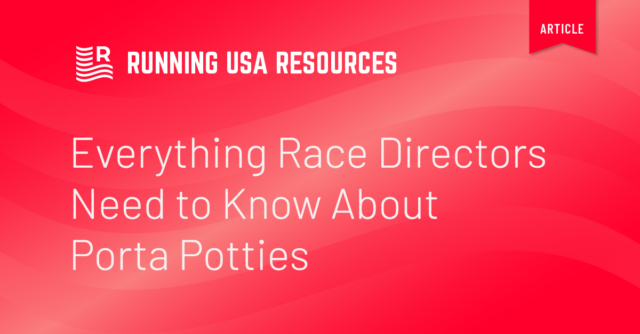By Kelly O’Mara
Well-known Boston Marathon race director, Dave McGillivray, who also founded DMSE Sports, once got locked in a port-a-potty 20 minutes before the start of the Boston Marathon. Everyone was waiting for him and he was stuck. “And then I dropped my two-way radio into the unit,” he said, while he was trying to get out.
The lesson here: If you’re going to lock a port-a-potty and keep it hidden just for race staff, don’t use it and leave the lock sitting outside where someone might accidentally re-lock it with you in it.
Every race director has port-a-potty stories—like that time someone lit a bank of them on fire the night before the event, another McGillivray classic. That’s because port-a-potties, port-a-johns, portable toilets are an absolute must-have for almost every race. If you don’t have enough port-a-potties in the right place, then athletes will end up peeing (or worse) in someone’s yard or behind a tree, and that will upset your town and permits and athletes. Yet, portable toilets remain a bit of a black hole for new RDs.
“These aren’t a nice-to-have; they’re a necessity,” said McGillivray. After water, port-a-potties are probably the most important thing to have at the start of your race. But how many, how should you position them, and what do you need to know?
How Many Port-a-Potties Do You Need?
While there are general industry standards on port-a-potty numbers for festivals and concerts, those don’t always apply for running races, according to a few sanitation rental companies we spoke with—because at concerts the usage is spread out over time, whereas at races usage tends to be concentrated. Every single runner is going to want to go right before the start, and maybe even more than once! That means the vast majority of port-a-potties need to be positioned in the start area and will see highly concentrated use for a short period of time.
McGillivray suggests one port-a-potty for every 50 runners as “optimum” or generous, but at a minimum you shouldn’t go under one port-a-potty for every 100 runners. Run Britain’s race director handbook recommends one per every 30 runners.
It also depends on a few port-a-math variables.
– More women in your race tends to mean you need more port-a-potties, simply because (to put it bluntly) it’s a lot faster for a man to pee standing up than for a woman to pee and then have to re-dress.
– If it’s going to be hot, runners often drink more and have to pee more.
– If they have to stand around at the start area longer, then they’re likely going to use the toilet more.
– If there are existing toilet facilities in your starting area—at a building or in a park structure— that are available to you, then you may want to integrate them into your plan and position your portable toilets nearby to maximize flow.
– It’s also possible to utilize separate portable urinals (such as the Kros four-way model), which would then offset the number of full port-a-potties needed.
How much should port-a-potties cost? ]
Often, for race directors, another factor is how many units they can afford. The national average, according to multiple rental companies, is approximately $150/week for one standard port-a-potty.
However, that varies widely by region and it’s possible to get bulk discounts if you work with a supplier regularly for multiple events. It’s like you’ll see everything from $40-125/unit. There are also bigger deluxe units, which can come with additional amenities like extra toilet paper dispensers.
Where (and How) to Position the Portable Toilets
The ratios listed above for number of toilets per athlete is solely for how many port-a-potties you need at the start. You may also need port-a-potties along the course and will definitely need a few at the finish if that’s in a different location.
On the race course, there are again a few factors to consider. If a race is shorter than a half-marathon, it’s possible you don’t need on-course stops, but that’s not necessarily the case, said McGillivray. Things to consider:
– Where can you place the port-a-potties, and how close to the course can you get them? If runners can’t see them while running, then they won’t use them, and you might as well not have them.
– Does your permit or municipality require port-a-potties both for athletes and/or for spectators?
– Don’t forget about those spectators and volunteers. Even if you don’t need port-a-potties for athletes on-course, if large numbers of volunteers are going to be out there for many hours, then you may need to make sure they have somewhere to go.
In general, McGillivray said, have a bank of 2-10 units in the first mile for people who couldn’t go before the start. Then have a bank of toilets every 3-4 miles, depending on placement options. A rule of thumb, in a marathon, is about one portable toilet on course for every 200 runners—depending on all of the above factors.
At the finish, you can get away with fewer toilets, because runners are trickling in, so it’s not one rush all at the same time, but you still likely need a bank of units depending again on the size of the event and on the post-race area. For instance, do you expect athletes to hang around the finish for awhile?
And then it’s time to consider how to position your toilets. For example, you don’t want to put on-course port-a-potties right next to the flow of runners with the doors facing towards the road, because then an athlete will step out of the toilet when they’re done and open the door right into oncoming runners. On-course port-a-potties need to be set back from the runners—ie. behind an aid station or closer to the curb—and/or be turned so the door faces away from oncoming runners, said McGillivray.
In terms of how to position a bank of port-a-potties, there are a few options:
1. One long line of port-a-potties with people forming one single line that feeds into all of the port-a-potties. However, this creates a longer line—which can dissuade runners at the start—and it takes time for people waiting to get into each unit. If someone isn’t paying attention to an open unit, then that unit could stand empty for a long time—which makes it essentially useless.
2. One long line of port-a-potties with people forming individual lines in front of each individual unit. The problem here is that if one person takes forever in a unit, then that line sits and waits and waits and waits. Athlete flow is critical in start areas.
3. The optimal positioning, said McGillivray, is to have pods of about five units, with one line forming in front of each pod. This allows a flow, but also breaks up the lines. He puts the five units in a line and then creates a gap to the next five units. The London Marathon, instead, puts each pod of units (5-8 port-a-potties) in a U-shape to maximize space. This will depend on the layout of your start area.
Port-a-Potty Lessons and Tips
Let’s talk about toilet paper. While race directors likely don’t need to know all the specifics of how exactly port-a-potties work, they do need to know how people work. If a unit runs out of toilet paper, then lots of runners will simply stop using it—rendering it fairly useless. That’s why McGillivray likes the units with three toilet paper dispensers and the toilet paper that has a tab that’s easy to unroll and get started in the dark hours pre-race. He also always has extra boxes of toilet paper on hand and will send someone with more rolls if a unit gets low or runs out.
Other lessons he’s learned:
– Individual port-a-loo capacity is rarely an issue for races. Since the flow of athlete use is the biggest limiter, you’re not as likely to fill up any one toilet. But be sure to check with your vendor so you know the capacity limits.
– With longer lead times on all supplies right now, you’ll likely need to order your port-a-potties one to two months in advance—which can be tough if you don’t yet know how many participants you’ll have. Make a rough estimate and talk to your vendor about options.
– Ideally, port-a-potties get placed the night before an event and picked up right after it’s over. “People don’t want units hanging around,” said McGillivray.
– You’ll also want to zip tie or lock them the night before, so they stay unused, but then make it part of your race morning operations to have a person assigned to go around and cut the zip ties.
– Don’t forget to place trash bins near each pod of port-a-potties.
And how do you find a good port-a-service? “Call another local RD and ask them,” said McGillivray. Since almost every race director has had to use a portable toilet service, they’ll have all the dirty details on how it went.
About the Author
 Kelly O’Mara is the former editor-in-chief of Triathlete Magazine and the founder of the .Triathlonish newsletter.
Kelly O’Mara is the former editor-in-chief of Triathlete Magazine and the founder of the .Triathlonish newsletter.

